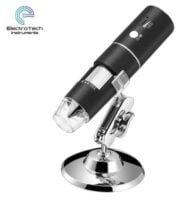Modern Biology Classroom Microscopes for 2026
October 27, 2025

Modern Biology Classroom Microscopes for 2026
From Cells to Systems: Why Microscopy Matters
In a biology classroom, the microscope is more than just a tool — it’s a portal to a world unseen. Students move from seeing leaves, insects, and pond water to observing cells, tissues, and microscopic life. With the right microscope and accessories, the learning becomes vivid, hands-on, and aligned with the curriculum. As schools plan ahead for 2026, now is the time to invest in a microscope-suite that will engage students and stand the test of time.
What to Look for in Classroom Microscopy
-
Durability & Safety: Classroom microscopes must endure day-in, day-out use, with sturdy stands, easy focusing and intuitive controls.
-
Flexibility of Magnification & Lighting: Biological features span scales; you’ll want something that can handle basic viewing (40x) through to high magnification or digital capture for sharing.
-
Digital Capability: More than ever, teachers want to project images, capture video and enable group learning. Digital or WiFi/USB microscopes make this far easier. My Tech Classroom+2Wiltronics+2
-
Curriculum Alignment: Equipment should support outcomes such as investigating cells and tissues, bodies and systems as per the Australian Curriculum. Wiltronics+1
-
Budget & Bulk-Procurement Options: Especially for labs serving multiple classes, ease of quoting, bulk discounts and service support are important factors.
-
🎓 Planning for the 2026 School Year
Since many schools prepare their budgets and resources in Term 4, this is the perfect time to audit your current microscopy suite:
-
Review current student-to-microscope ratio: Are students waiting long to use the scope?
-
Identify missing tech: Do you require digital capture/projection, or still rely on single-eyepiece monoculars?
-
Consider future teaching: For Years 11-12 biology, will you need high magnification, digital imaging for portfolios or live capture for class demonstration?
-
Budget for bulk: Ask Wiltronics for education bulk pricing and delivery scheduling so equipment is in place by Term 1, 2026.
-
Align with curriculum: Ensure your microscope hardware supports outcomes around “cells and systems”, “body systems”, “biological change”. Wiltronics+1
-
🔬 Key Microscope Types & Classroom Uses
Here are some primary microscope types suitable for biology teaching, with example product categories/products you can find on the Wiltronics site:
Digital USB / WiFi Microscopes
These allow projection of images to screens or capture for student reports.

USB Digital Microscope 2 MP – Budget-friendly, plug-and-play for classrooms starting digital microscopy.

WiFi Digital Microscope – USB, 2 MP, 50×‑1000× – Higher magnification, connectivity for tablets/phones, good for whole-class viewing.
5 MP USB Digital Microscope – Extra resolution for detailed cell/tissue work or student portfolios.
Stereo / Dissection Microscopes
-
For 3D viewing of specimens, insects, plants, or dissection work.
Category: Microscopes – Stereo, Dissection & Zoom
Biological (Monocular/Binocular) Compound Microscopes
-
Traditional microscope for slides, cells, tissues.
Category: Microscopes – Biological, Monocular & Binocular
🧫 Supporting Accessories & Consumables
To maximize student engagement and lesson frequency without downtime, you’ll also want to invest in accessories and consumables:
-
Slides, coverslips, prepared slide sets – ready for use or for students to prepare their own.
Category: Microscope Slides & Equipment
❓ FAQs
Q: Are digital microscopes suitable for all ages?
A: Yes — digital models are especially good for group viewing and younger students who benefit from projection, though traditional scopes still have their place as students mature.
Q: Does Wiltronics support bulk educational orders?
A: Yes — their product categories indicate education bulk packs, and their knowledge base highlights support for schools nationwide.
Q: How often should microscope equipment be refreshed?
A: High-use classroom microscopes often last 5–10 years; digital modules or accessories may need refresh sooner as technologies evolve. Planning now for 2026 gives you time.
🚀 Equip Your Biology Lab for 2026
Transform your biology teaching with modern microscopy. Whether you’re upgrading to digital, adding stereo-dissection options, or building a full microscope suite for multiple classes, Wiltronics has the tools to deliver reliability, education alignment, and future readiness.
© Electrotech Brands Pty Ltd 2025






Write a Comment
You must be logged in to post a comment.